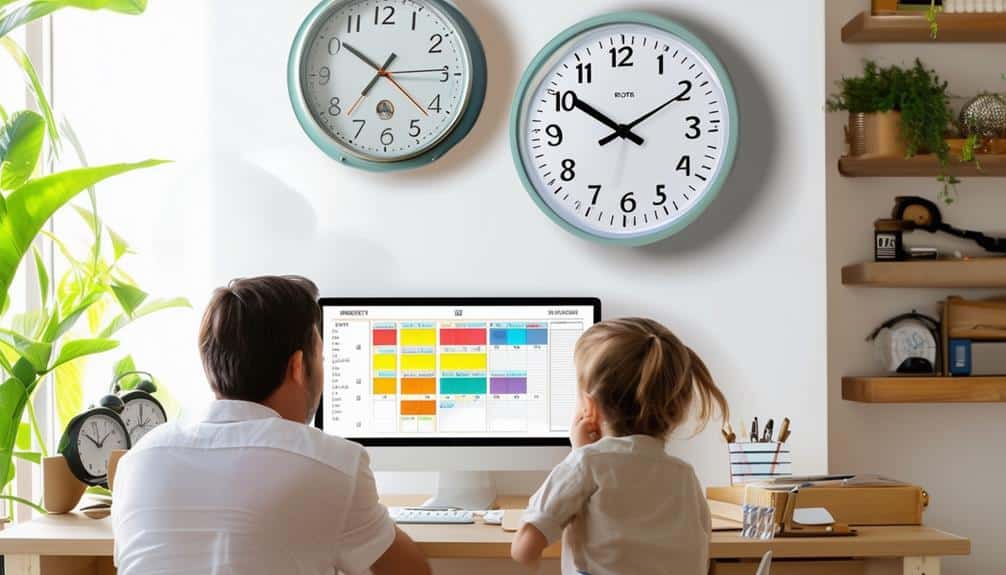Children lacking executive skills often struggle to control impulses, manage emotions, and follow classroom rules. Parents can implement structured strategies like visual schedules and task breakdowns to support these children. These tools help create a clear path for children with attention-deficit/hyperactivity disorder or other mental disorders. Using a graphic organizer or white noise during reading can also improve focus. Encouraging deep breaths and practicing dialectical behavior therapy techniques can further support emotional regulation and foster a more positive learning environment.
Incorporating routines that build organizational skills and time management is crucial for children lacking executive skills. Designated spaces for belongings, consistent classroom rules, and regular check-ins with a healthcare provider can make a significant difference. Celebrating small victories boosts confidence, helping children become more independent and resilient. By embracing these strategies, parents can improve their children’s executive function skills, enhance their academic achievements and social interactions, and lead a healthier, more balanced life.
Key Takeaways
- Create visual schedules with pictures to help children understand and follow daily routines.
- Break tasks into smaller, manageable steps using checklists to aid task completion.
- Use digital calendars and timers to improve time management and adherence to schedules.
- Teach and practice emotional regulation techniques to enhance children’s ability to manage their emotions.
- Designate specific areas for belongings and activities to maintain an organized and functional environment.
Lacking Executive Skills
Visual schedules, which utilize pictures or symbols to represent activities, provide essential structure and predictability for children with executive dysfunction. These tools are invaluable in helping children understand what to expect throughout their day, thereby reducing anxiety and promoting a sense of security. By offering a visual representation of tasks, children can better grasp the sequence of their daily routines, which is pivotal for those who struggle with executive functioning skills.
The benefits of visual schedules extend beyond mere predictability; they play a crucial role in fostering independence. Children who see their tasks visually are more likely to engage with them proactively. This independence is further supported as children learn to navigate their schedules without constant adult intervention, boosting their confidence and self-efficacy.
Moreover, visual schedules can be easily tailored to meet specific needs and preferences, making them a flexible tool for parents and educators. These schedules help children manage tasks by incorporating task breakdowns in smaller, more manageable steps. This structured approach reduces overwhelm and teaches children prioritization skills, leading to more efficient task completion and an overall enhancement in their daily functioning.
Task Breakdowns
Building on the effectiveness of visual schedules, breaking tasks into smaller, manageable steps can further support children with executive dysfunction in managing their daily routines. Task breakdowns enable children to tackle tasks that might otherwise seem overwhelming, making them more approachable and less intimidating. Utilizing checklists or visual reminders can assist children in following through with each step, reinforcing their progress and offering a clear path to completion.
Teaching children to prioritize tasks within the breakdown can significantly enhance their organizational skills and productivity. By identifying the most critical steps, children can allocate their time and energy more effectively, ultimately leading to better outcomes. Encouraging them to complete one step at a time can also build their confidence, as each accomplished step provides a sense of achievement and reduces the overall perception of the task’s complexity.
Task breakdowns make tasks more manageable and foster a sense of accomplishment as children progress through each step. This method empowers them to develop a systematic approach to their activities, bolstering their ability to manage simple and complex tasks independently. Integrating task breakdowns into daily routines can be a transformative tool for enhancing children’s executive functioning.
Time Management Tools

Practical time management tools are indispensable for aiding children with executive dysfunction to maintain organization and stay on track with their daily responsibilities. Utilizing digital calendars can significantly enhance a child’s ability to visualize and manage their schedule. These tools allow for clear delineation of tasks and help children anticipate upcoming events, thereby reducing anxiety associated with unknowns.
Timers are another essential tool for helping children set specific activity time limits. Children can learn how to manage their time and prioritize responsibilities effectively using timers. This practice guarantees that tasks are completed within a designated time frame and helps develop time awareness.
Incorporating routines and schedules into daily life can further boost the effectiveness of these time management tools. Establishing consistent routines fosters a sense of responsibility and accountability, making daily tasks more predictable and manageable. Encouraging children to estimate the time required for functions can also enhance their ability to allocate time efficiently.
Organization Techniques
Implementing organization techniques can significantly simplify daily routines and reduce stress in addressing executive dysfunction. Effectively prioritizing tasks and using visual aids such as color-coded systems and labels can enhance a child’s ability to manage their environment. Structured, consistent practices foster independence and make it easier for children to access and maintain their belongings.
Simplify Daily Routines
Establishing a structured environment with designated spaces for belongings can significantly reduce daily stress and improve time management for both parents and children. Simplifying daily routines through effective organization techniques fosters a sense of order and promotes children’s independence and responsibility. Parents can help their children navigate daily tasks more efficiently by creating a streamlined routine.
Here are four practical strategies worth exploring:
- Designated Spaces: Assign specific areas for frequently used items such as school supplies, clothing, and toys. This helps children know where to find and return items, reducing clutter and saving time.
- Color-Coding Systems: Utilize color-coding for different categories of items or activities. For example, use blue bins for school-related materials and green bins for toys. This visual aid can make the organization more intuitive for children.
- Regular Tidying: Encourage children to tidy up regularly. Set aside a few minutes each day for this task to prevent disorganization from accumulating. This practice fosters good habits and a sense of responsibility.
- Accessible Storage Solutions: Implement easy storage solutions for children to access. Clear bins, labeled drawers, and open shelves can make it simpler for children to retrieve and store their belongings independently.
Prioritize Tasks Effectively
Prioritizing tasks effectively can significantly enhance productivity and reduce stress for parents and children. Task prioritization begins with categorizing tasks based on urgency and importance, allowing families to focus on what truly matters. One effective method is visual ranking, achieved through color-coding or numbering tasks. This visual approach helps parents and children quickly identify high-priority tasks, making the daily agenda more manageable.
Another practical strategy is to create a daily to-do list. This list helps identify priorities and offers a structured way to organize them. For tech-savvy families, digital task management apps provide a versatile platform for efficient prioritization. Apps like Todoist or Trello allow for the easy categorization of tasks and can be shared among family members to ensure everyone is on the same page.
Furthermore, breaking down tasks into smaller, manageable steps can make challenging projects less overwhelming. This approach fosters a sense of accomplishment as each small task is completed, thereby maintaining motivation and reducing procrastination. By implementing these evidence-based strategies, parents can better support their children in managing their responsibilities, leading to a more harmonious and productive household.
Utilize Visual Aids
Visual aids serve as powerful tools to help children with executive dysfunction stay organized and reduce anxiety through structured and predictable routines. These tools enhance executive function skills by providing visual cues that simplify complex tasks and support organization. Here are four effective strategies to implement visual aids for kids executives:
- Color-Coded Folders and Labeled Bins: Use color-coded folders and labeled bins to help kids quickly categorize and locate their items. This method reduces confusion and promotes a clutter-free environment.
- Visual Schedules with Pictures or Symbols: Create visual schedules using pictures or symbols to outline daily routines. This approach provides structure and predictability, alleviating anxiety and helping kids understand what comes next.
- Task Checklists: Develop visual reminders and checklists that break down tasks into manageable steps. This strategy encourages task completion by allowing children to focus on one step at a time, boosting their confidence and independence.
- Designated Spaces and Storage Solutions: Establish specific areas for belongings and use effective storage solutions. This practice supports organizational habits and ensures children maintain a tidy and efficient environment.
Incorporating these visual aids can significantly help kids improve their executive function skills, making daily routines more manageable and less stressful.
Emotional Regulation

Teaching children profound breathing exercises enhances their mood regulation and helps them manage stress effectively. Deep breathing exercises can be a cornerstone for mood regulation, providing children with a tangible tool to calm their nervous system. Integrating mindfulness techniques, such as guided imagery and progressive muscle relaxation, can enhance self-awareness and emotional control. These practices help children recognize their feelings and develop a sense of mastery over their reactions.
Positive reinforcement plays a vital role in encouraging the consistent use of these coping skills. Praising children when they successfully utilize deep breathing exercises or mindfulness techniques reinforces their efforts and promotes the continuation of these healthy habits. For example, acknowledging a child’s effort to take deep breaths during a stressful moment can boost their confidence and resilience.
Creating a supportive and understanding environment is essential for facilitating mood regulation. Encouraging open discussions about emotions and validating a child’s feelings can help them feel understood and secure. This supportive atmosphere allows children to express their feelings freely and learn how to manage them effectively. Parents can contribute significantly to their child’s emotional intelligence and overall well-being by fostering these practices.
Encouraging Independence
Encouraging independence in children with executive dysfunction is vital for building confidence and self-reliance. Parents can support their child’s development of executive function skills by fostering decision-making skills, implementing routine schedules, and promoting problem-solving abilities. Balancing structured support with opportunities for autonomy enables children to thrive and manage their responsibilities effectively.
Foster Decision-Making Skills
To foster decision-making skills and promote independence, it is essential to encourage children to make choices by offering them restricted options. This approach helps foster decision-making skills, promote independence, and develop critical thinking abilities. By creating a structured yet flexible environment, children can learn to evaluate their choices and understand the consequences of their decisions.
Here are four practical strategies to implement this:
- Offer Limited Choices: Present children with a few options rather than an overwhelming number. For example, let them choose between two snacks or two activities. This helps them make choices without becoming overwhelmed.
- Safe Consequences: Allow children to experience the outcomes of their decisions in a controlled setting. This enables them to develop critical thinking abilities by reflecting on what worked and what didn’t.
- Practice Decision-Making: Provide regular opportunities for children to practice making decisions. Simple choices, like selecting a book to read or a game to play, can build their confidence and autonomy.
- Discuss Outcomes: Support children in evaluating their choices by discussing the results. Please encourage them to contemplate different outcomes and learn from their experiences to enhance their independence.
Implement Routine Schedules
Establishing consistent routine schedules provides children with executive dysfunction the necessary structure and predictability to foster independence and reduce anxiety. A well-defined routine enables children to anticipate upcoming activities, creating a stable environment that diminishes uncertainties and stress. This predictability is vital in helping them feel secure and capable of tackling daily tasks.
Routine schedules also significantly enhance time management skills. By following a structured timetable, children learn to allocate appropriate amounts of time to each activity, which helps them stay on track and complete tasks efficiently. This practice cultivates a sense of responsibility and builds essential executive function skills such as planning and organization.
Moreover, consistent routines encourage self-regulation by embedding a sense of accountability and responsibility. When children know what to expect and what is expected of them, they are more likely to take ownership of their actions and decisions. This independence is a critical component of their overall development and well-being.
Promote Problem-Solving Abilities
Fostering problem-solving capabilities in children with executive dysfunction is essential for nurturing their independence and resilience. Encouraging these skills helps children navigate daily challenges and bolsters their confidence and critical thinking abilities.
To effectively promote problem-solving abilities, consider the following strategies:
- Allow Decision-Making: Let children make choices, even small ones, to practice weighing options and foreseeing consequences. This empowers them to trust their judgment and learn from their mistakes.
- Brainstorm Solutions Together: When faced with a challenge, guide children through brainstorming solutions. Please encourage them to consider multiple approaches, fostering creativity and flexibility.
- Support Critical Thinking: Instead of providing immediate answers, ask open-ended questions that prompt children to analyze situations and develop solutions. This enhances their critical thinking skills and promotes independence.
- Celebrate Problem-Solving Efforts: Recognize and praise children’s attempts at problem-solving, regardless of the outcome. Celebrating their efforts builds confidence and motivates them to tackle future challenges.
Structured Environments

Establishing structured environments for children with executive dysfunction can significantly enhance their ability to manage tasks and reduce anxiety. Structured environments provide essential visual cues and predictability, allowing children to navigate daily activities quickly. Utilizing color-coded systems for organizing belongings and tasks can notably improve clarity and reduce the cognitive load required to locate items or understand schedules. For instance, assigning specific colors to different categories of school supplies or activities can help children quickly recognize and retrieve what they need.
Clear routines are another cornerstone of a structured environment. Predictable schedules create a sense of stability, which is especially beneficial for children who struggle with executive dysfunction. For example, consistent morning and evening routines can help minimize stress and foster a more orderly shift between activities.
Designated spaces for specific activities and items further enhance organization and efficiency. Clearly defined areas can empower children to manage their responsibilities independently, whether it’s a homework station equipped with all necessary supplies or a dedicated spot for backpacks and shoes. Implementing storage solutions, such as bins and shelves, can also aid in maintaining an orderly environment, ultimately contributing to a child’s ability to function more effectively.
Celebrating Progress
Recognizing and celebrating even the tiniest milestones can significantly enhance a child’s motivation and self-esteem, providing essential reinforcement in managing executive dysfunction. Celebrating progress is a pivotal strategy that boosts confidence and encourages perseverance and a growth mindset. Here are some practical ways to celebrate achievements:
- Praise Efforts Over Outcomes: Highlighting the effort put into a task fosters a growth mindset, teaching children that persistence is just as important as the result.
- Create a Visual Progress Chart: Use charts or graphs to display incremental progress visually. This helps children see tangible evidence of their achievements, reinforcing their sense of accomplishment.
- Set Small, Achievable Goals: Break larger tasks into smaller, manageable steps. Celebrating these smaller goals can provide continuous motivation and a sense of steady progress.
- Incorporate Positive Reinforcement: Celebrate achievements with rewards and verbal affirmations. Positive reinforcement can significantly bolster a child’s motivation and willingness to tackle challenging tasks.
Frequently Asked Questions
How to Override Executive Dysfunction?
To override executive dysfunction, implement digital calendars, utilize checklists, break tasks into 5-minute actions, establish organizational systems, and take regular, short breaks. These strategies can enhance time management, focus, and overall productivity.
How to Get Unstuck Executive Dysfunction?
Surprisingly, recognizing signs of feeling stuck can coincide with proactive measures like breaking tasks into smaller steps, using organizational tools, and practicing self-compassion. These evidence-based strategies empower people to manage executive dysfunction effectively.
How Do You Push Through Executive Dysfunction?
To push through executive dysfunction, employ digital organizational tools, break tasks into manageable steps, set achievable goals, prioritize tasks, take regular breaks, and seek professional support to develop effective coping strategies, fostering sustained productivity and well-being.
What Is the 30% Rule for ADHD?
The 30% rule for ADHD involves breaking tasks into 30% increments, which enhances focus and productivity by making tasks more manageable. This method alleviates overwhelm, fosters consistent progress, and improves time management for people with ADHD.
Conclusion
Visual schedules, task breakdowns, and time management tools are essential for helping children with attention-deficit/hyperactivity disorder control their behaviors and emotions. By creating structured environments and following classroom rules, parents can support their children in managing their executive function skills and developing better organizational skills. Tools like graphic organizers and white noise can further aid children in focusing during reading or other cognitive tasks.
Incorporating mood regulation strategies, such as taking deep breaths and practicing Dialectical Behavior Therapy techniques, can help children manage positive and negative emotions. This balance fosters independence and builds confidence in their abilities, whether following classroom rules or completing book reports. Celebrating small successes boosts motivation and encourages progress in their executive function development.
Parents play a pivotal role in their children’s mental health and well-being. By consistently applying these strategies and collaborating with a pediatric occupational therapist, they can help their children overcome challenges associated with executive dysfunction. This approach improves academic performance and strengthens social skills and emotional control, leading to a healthier, more balanced life.


Recent Comments